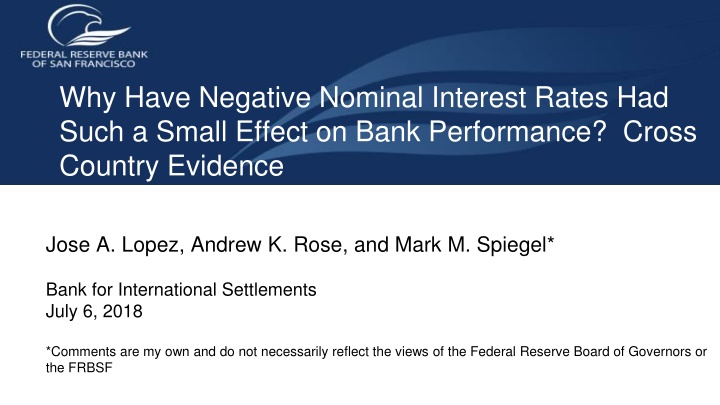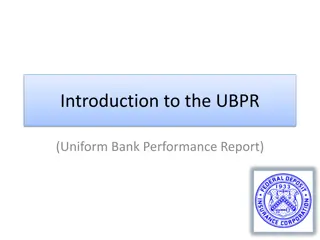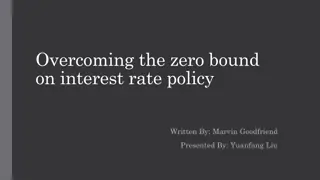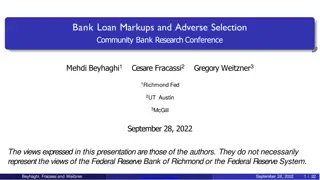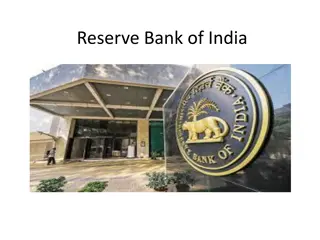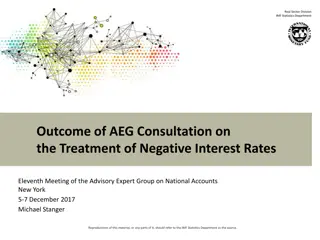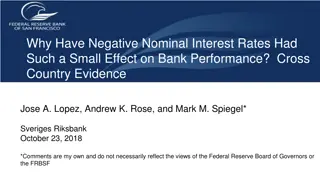Impact of Negative Nominal Interest Rates on Bank Performance
Negative nominal interest rates, implemented following the financial crisis, have had a limited effect on bank performance globally. While low rates reduce profitability, banks have shown resilience through adjustments in funding allocations and non-interest income sources. Studies suggest that responses at the bank level have mitigated adverse impacts on profitability and lending. However, challenges remain in assessing the exact influence of negative rates on bank performance due to underlying economic fundamentals. Cross-country evidence indicates that banks generally resist charging negative rates on deposits, which disrupts monetary transmission mechanisms.
Download Presentation

Please find below an Image/Link to download the presentation.
The content on the website is provided AS IS for your information and personal use only. It may not be sold, licensed, or shared on other websites without obtaining consent from the author.If you encounter any issues during the download, it is possible that the publisher has removed the file from their server.
You are allowed to download the files provided on this website for personal or commercial use, subject to the condition that they are used lawfully. All files are the property of their respective owners.
The content on the website is provided AS IS for your information and personal use only. It may not be sold, licensed, or shared on other websites without obtaining consent from the author.
E N D
Presentation Transcript
Why Have Negative Nominal Interest Rates Had Such a Small Effect on Bank Performance? Cross Country Evidence Jose A. Lopez, Andrew K. Rose, and Mark M. Spiegel* Bank for International Settlements July 6, 2018 *Comments are my own and do not necessarily reflect the views of the Federal Reserve Board of Governors or the FRBSF
Low interest rates concern for banks Following financial crisis, rates reduced towards zero lower bound (ZLB) Potential obstacle to bank profitability Nominal deposit rates could not be reduced below zero without eroding banks customer base. Low interest rates reduce bank profitability [Jobst and Lin (2016)]. Concern confirmed empirically Borio, et al (2017) bank profitability reduced at low rates of interest Borio and Gambacorta (2017) bank lending less responsive to policy rates around ZLB, weakening transmission mechanism
Even worse at negative rates Adjustments in deposit rates likely to hit a hard stop at the zero bound. Banks generally unwilling to charge negative nominal interest rates on deposits, especially for smaller customers Eggertson, et al (2017): Negative rates disrupt monetary transmission Evidence from aggregate data from five countries and the euro area as well as bank-level data from Sweden. Rostagno, et al (2016): movements into negative rates may induce lending by increasing cost of hoarding cash
Many individual currency studies of negtive rates Bank-level studies Most conclude that responses at bank level mitigated adverse effect of negative rates on bank profitability and lending Increasing non-interest income (such as increased fees) Adjust funding allocations to rely less on deposits Adjustments depend on both bank business model and size, as both influence reliance on deposit funding However, move to negative rates likely reflects fundamentals Leaves it difficult to identify changes in bank profitability solely from negative rates.
Relevant literature Studies under low positive rates Borio, et al (2017), Borio and Gambacorta (2017), Delis and Kouretas (2011), Bikker and Vervliet (2017) Economies under negative nominal interest rates Bech and Malkhozov (2016): 4 CBs in Europe since 2014 Negative rates similar to low positive rates Turk (2016): Danish and Swedish bank margins roughly stable across the zero threshold
Micro data negative rate studies for individual currencies Heider, et al (2017): 46 eurozone banks 2013-2015 Negative rates in euro area induced deposit-dependent banks to cut lending, and reallocate loans towards more risky firms. Nucera, et al (2017): 111 eurozone banks Negative rates induced smaller banks to increase riskiness Basten and Mariathasan (2018): 68 Swiss banks Banks with higher excess reserves raised fees and interest income to compensate for negative liability margins Demiralp, et al (2017): 205 euro area banks HD banks extend more loans under negative rates than LD
Multi-currency panel allows for global shocks Different economies move to negative rates at different times Include fixed time effects to control for global conditions Global shocks particularly relevant over sample period [Rey (2015)] Some countries in sample never experience negative rates Can be viewed as a difference-in-difference study Compare banks in economies that experienced negative rates, before and after policy rates turned negative Local conditions also likely affect both bank profitability and monetary policy Respond by instrumenting proxies for local conditions
First study pooling European and Japanese banks under negative rates Annual income statements for 5,113 banks from 2010-2016 14 different currencies, one of which is the 19 country euro Countries go negative at different times for different reasons Example: Movements into negative rates different in floating and pegged exchange rate countries Latter respond more to pressures that might undermine the peg. Sample also includes large number of banks Allows analysis of banks most exposed to negative interest rates Split data into sub-samples by: a) bank size, and b) reliance on deposits.
Results: Bank profitability unaffected by negative nominal interest rates No substantive effect on net income from negative rates. ssssNotable because sample includes relatively large share of small and high-deposit banks Both expected to be more exposed to negative rate losses Do find statistically significant losses in net interest income Statistically significant losses both on lending income and other interest income Mitigated by reductions in interest expenses, but not sufficiently Notably, banks do not substantially reduce deposit expenses Heterogeneity: Large banks do achieve reduction in deposit expenses, small banks don t
Losses on net interest income made up on non- interest income Significant gains in net non-interest income Increases in fees Increases in other non-interest income (capital gains, gains on securities, insurance) Differences by bank type Large banks also reduce other interest expenses more than their smaller counterparts. Low-deposit (LD) banks do better under negative interest rates than high-deposit (HD) counterparts LD banks actually suffer bigger reductions in net interest income, but also achieve larger increases in net non-interest income
Data Fitch Global Banking database Balance sheet and income statement variables for individual banks, 2010-2016 28 European countries and Japan Variety of monetary regimes, including monetary unions, exchange rate peggers, and inflation targeters Data begins 2 years before negative nominal interest rates Includes all negative nominal interest rate countries through 2016
Difference from the existing literature Variety of countries with different monetary regimes Enter negative rates at different points in time, if at all. Five economies experienced negative nominal policy interest rates: Denmark, EMU, Japan, Sweden, and Switzerland Denmark first into negative rates July 2012 Swiss interest rates most negative (on sight deposit rates at -0.75%) Similar countries that did not go negative Bulgaria, Czech Republic, Hungary, and the UK Allows time fixed effects to account for global conditions More generally, difference-in-differences strategy, since not all experienced negative rates, and none for the entire sample.
Data set is large Over 5,100 banks and more than 30,00 observations Allows examination of effects of negative rates on banks that differ by size and deposit-reliance Identify large as assets exceed $10 billion (1/8 of sample) Define HD as deposits exceeded 75% of funding (4/5 of sample) Complications Multiple accounting methods Generally choose unconsolidated observations Japanese banks report in first quarter Truncate outliers at 1% and 99%
Losses on net interest income made up on non- interest income Significant gains in net non-interest income Increases in fees Increases in other non-interest income (capital gains, gains on securities, insurance) Differences by bank type Large banks also reduce other interest expenses more than their smaller counterparts. Low-deposit (LD) banks do better under negative interest rates than high-deposit (HD) counterparts LD banks actually suffer bigger reductions in net interest income, but also achieve larger increases in net non-interest income
Little overall difference in profitability across ZLB Descriptive Statistics
No apparent differences in raw data Figure 1: Bank profitability under positive and negative policy rates
Base specification Conventional least-squares panel specification: Yijt= NEGIjt + { i} + { t} + ijt (1) where: Yijt is dependent variable for bank i in economy j for year t NEGIjt is 1 if country j had a negative nominal policy interest rate during year t, and 0 otherwise (nominal rates>1 are dropped) { } and { } are comprehensive sets of bank- and time-specific fixed effects represents a residual, assumed to be well-behaved
Base specification (2) Coefficient of interest is Average effect of negative nominal interest rates Use robust standard errors, clustered by bank. Consider number of measures of bank performance Calculated as ratios of total assets Drop outliers, observations outside (1,99) percentiles Confirm results insensitive to the use of earning assets instead of total Exclude values of net income (to total assets) greater than 20% in absolute value
Base specification results Negative Nominal Interest Rates and Bank Profitability
Base results indicate small negative rate impact Economically small but positive and statistically insignificant effect on bank net income, compared with low positive rates Masks large movements in income components Net interest income falls significantly by around 5.4 bp Almost precisely offset by gains in net non-interest income of 5.2 bp. Offsetting results suggest banks are reluctant to charge their depositors negative rates Results in losses from interest income Compensate for losses with gains from non-interest income
Results robust to variety of perturbations Sensitivity Analysis
Decomposition of net interest income Negative Nominal Interest Rates and Bank Interest Income and Expenses
Interest expense cuts less than revenue losses Both gross interest income and expense show economically significant and statistically significant declines Decline in expenses is smaller Decline in gross interest income largest for loan income Other interest income decline also significant Customer deposits insignificant Matches conventional wisdom Banks suffer interest losses but can t pass fully on to depositors Hence, bank net interest income declines
Differences across banks Large banks seem more nimble than smaller banks Suffer smaller and insignificant declines in gross interest income Also cut expenses further, avoiding losses on net income LD banks suffer significantly greater losses in gross interest income, especially income from loans To offset losses, LD and HD banks lower interest expenses However, LD banks lower other interest expenses more More reliant on other, market-based funding sources Differences in deposit expenses much smaller
Decomposition of non-interest income Negative Nominal Interest Rates and Bank Non-Interest Income and Expenses
Interest expense cuts less than revenue losses Increase in net non-interest income stems from an increase in gross income, rather than a decline in expenses Two sources increasing gross income, both significant: Increase in net fees Improvements in other types of non-interest income, such as capital gains and gains on securities and insurance But change in most non-interest expenses insignificant Exception is other non-interest expenses, including capital gains on securities and interest expenses, which increase
Differences across banks Few substantive differences between large and small banks Relatively large discrepancies across HD and LD banks Modest differences in point estimates for non-interest expenses Increase in gross non-interest income for LD banks about 10 times size of that enjoyed by HD banks Most from increases in non-fee income, which may reflect gains on securities May be associated with unanticipated movements into negative rates Benign impact of negative rates might in part reflect immediate capital gains on bond holdings for LD banks However, remaining under negative rates may not be painless Medium-tern impacts of negative rates may differ
Differences across monetary regimes Data includes three different types of monetary regimes Large number members of EMU, (3 Baltic countries joined) Largest negative rate monetary regime Floating exchange rates Japan, Sweden and Switzerland (but not Czech Republic, Hungary or the UK) experienced negative nominal interest rates. Fixed exchange rates Bulgaria and Denmark (Estonia, Latvia and Lithuania prior to EMU entry) Only Denmark experienced negative interest rates. Analysis implicitly exploits this panel variation Next, reexamine results by monetary regime
Results for different monetary regimes Table 4: Negative Nominal Interest Rates Effects Across Economies
Results indicate importance of panel approch Results for Japan and Germany erroneously negative Unable to control for time fixed effects; interpret with caution Demonstrates advantage of cross-country panel Literature often uses banks from single monetary regime Other samples more credible Countries with exchange rates pegged to the Euro European countries that maintained flexible exchange rates Flexers plus Eurozone All economies with flexible exchange rates
Much heterogeneity across monetary regime panels None of the five panel estimates indicate significant effect of negative nominal interest rates on bank profitability Stark contrast with national results indicating significant decline in bank profits in both Japan and Germany Decomposition of sub-panels consistent with full sample Observed significant effect on net interest income always negative Significant coefficients for net non-interest income positive Result that negative rates only have a small overall effect appears driven by floating exchange rate economies
Conclusion (1) Examine banks under negative nominal interest rates First study under negative rates for different monetary regimes Panel allows conditioning for global shocks, and dis-aggregating by both size and dependence on deposit-funding Find little overall impact on bank profitability, compared with low positive rates Components of income respond significantly Decline in net interest income Largely offset by increases in non-interest income Results driven by countries with floating exchange rates, and small or LD banks
Conclusion (2) Overall, results suggest banks fare relatively well under negative nominal rates, compared to low positive Considerable heterogeneity raises caution in concluding that monetary transmission mechanism unchanged Particularly since positive returns in other non-interest income may be unsustainable over medium term Capital gains from negative interest rate surprises unlikely to persist
Results for activity Appendix Table A3: Negative Nominal Interest Rates and Other Bank Activity
